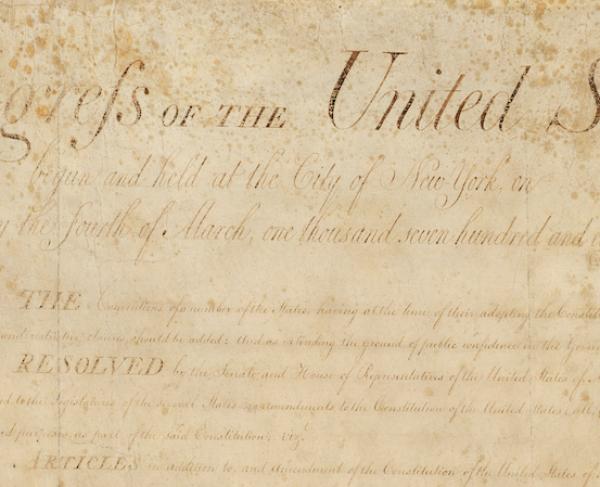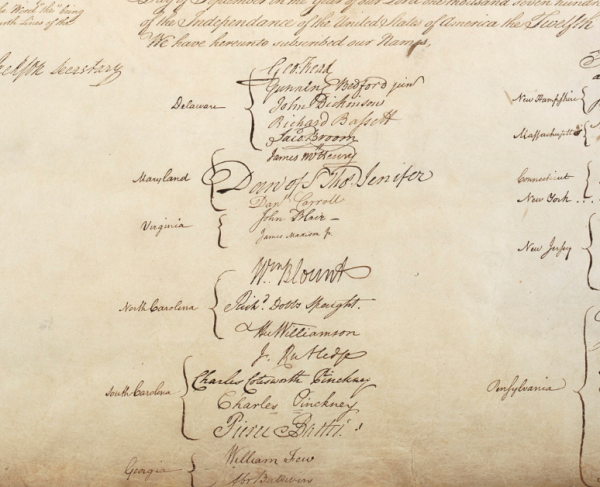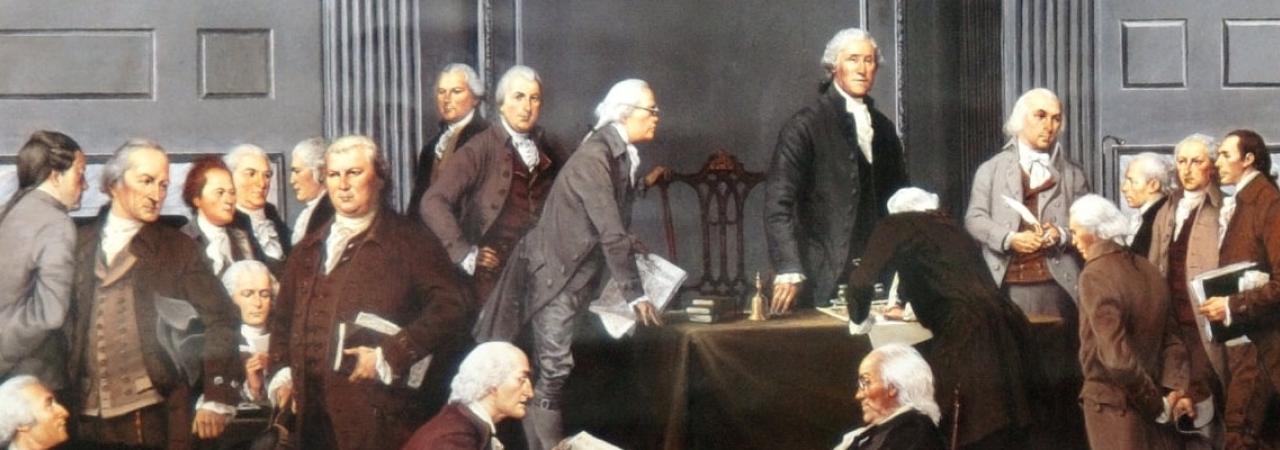
The war between the Thirteen American colonies and Great Britain was underway. The First Continental Congress, which had met in Philadelphia from September to October 1774, had organized to launch a collective affront to British taxation and unite in an economic boycott on all British goods. The Second Continental Congress, which formed on May 10, 1775, did not just organize an embargo but organized a de facto government in order to fight one of the largest militaries and political superpowers in Europe. Congress adopted the “Declaration of the Causes and Necessity of Taking Up Arms” to establish their military intent against Britain.
On June 14, 1775, they created the Continental Army. In one last show of goodwill, Congress drafted the Olive Branch Petition to implore Britain to peacefully end the conflict and grant the Thirteen Colonies their independence. The Petition was not acknowledged by King George III. As the conflict progressed, Congress began drafting a document that further unified the colonies, gave guidelines on how Congress should operate, and legitimized the budding nation in the eyes of the world. This document was the Articles of Confederation and Perpetual Union.
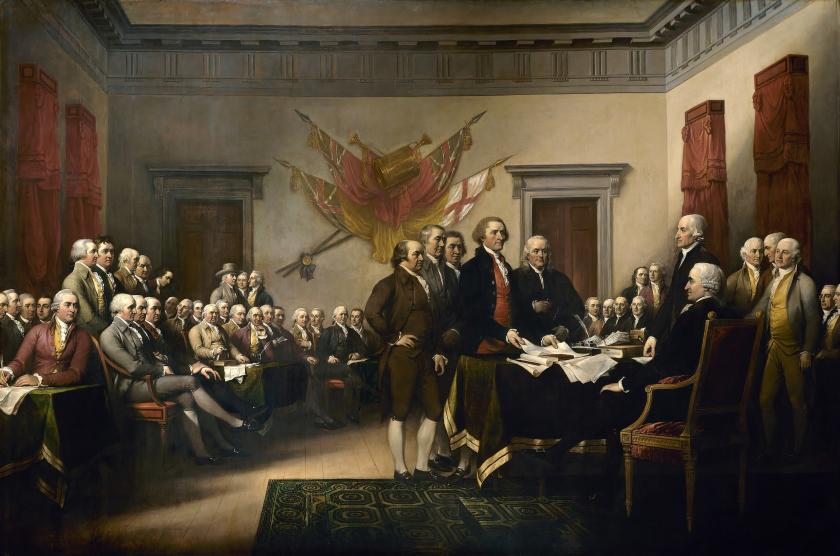
Known simply as the “Articles of Confederation,” this document preserved the independence and sovereignty of the States while unifying them under one Constitution obligation. These articles were separate from the Declaration of Independence, although both written around the same time. The Declaration of Independence, drafted by Thomas Jefferson, was the formal explanation of why the Thirteen Colonies had declared independence from Great Britain. While the previous Declaration of the Causes and Necessity of Taking Up Arms outlined why the Thirteen Colonies were starting an armed conflict, the Declaration of Independence established why the Thirteen Colonies wanted sovereignty and independence from their former ruler. The document is comprised of a list of grievances against King George III and the ideologies of the new country. Today several accepted American values and tenants come from this document, such as:
“We hold these truths to be self-evident, that all men are created equal, that they are endowed by their Creator with certain unalienable Rights, that among these are Life, Liberty, and the pursuit of Happiness.”
The Declaration of Independence was officially ratified on July 4, 1776. Because of the importance of this document, America’s Independence Day is celebrated on July 4th every year.
The Articles of Confederation took longer to write. Unlike the Declaration of Independence, the Articles of Confederation were to be the guiding principles of governing the new United States of America and the pragmatic instructions on how to run a country. The Continental Congress struggled and debated issues regarding state sovereignty, what powers a centralized government should hold, how congress should vote, and whether states could claim “unclaimed” western lands. While these issues were debated, pressing issues regarding the military and money required Congress’s attention as they traveled from city to city escaping the escalating military conflict. After drafting and redrafting the document, the final draft of the Articles of Confederation was completed on November 15, 1777.
Twelve states ratified the Articles by February 1779, fourteen months after the submission of its completed draft. These ratifications occurred with little alteration to the Articles and the Continental Congress adopted the Articles as its de facto governmental procedures. Maryland, the lone holdout, worried that Virginia could claim large swaths of land west of the Ohio River. Hoping to limit the size of their neighboring state, Maryland refused to ratify unless all states ceded their claims to Western land and relented them to the national interest. If the land was in the national domain then these lands required congressional approval to be distributed to states. Almost four years after the Articles of Confederation were drafted, Maryland ratified the Articles on February 2, 1781. On March 1, the Articles became the official ruling document of the United States.
The document, although long in approval, was far from perfect. The Article contained thirteen articles that divvied power between the central Congress and the individual states based on the idea of friendship between the states. In Article Three, Congress defines this friendship:
"The said States hereby severally enter into a firm league of friendship with each other, for their common defense, the security of their liberties, and their mutual and general welfare, binding themselves to assist each other, against all force offered to, or attacks made upon them, or any of them, on account of religion, sovereignty, trade, or any other pretense whatever."
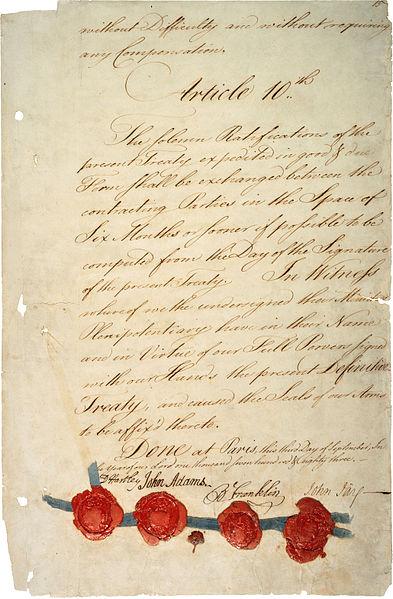
The Articles, in general, gave limited power to the central government. Congress could sign treaties and alliances with foreign nations; could regulate post offices, appoint officers in the military, and regulate armed forces; could request requisitions from the states; and could do other administrative functions. Congress could not declare war or peace with other nations without the consent of a super-majority of the states; could not levy taxes on states; could not require states send soldiers to fight in a national army; and could not interfere with state’s sovereignty. Congress was granted only the power that Great Britain had previously held over the Thirteen Colonies before the Intolerable Acts were issued. These limits were deliberate. The United States was reluctant to establish a strong central government while fighting a war against the ideas of “tyranny.”
The shortcomings of the Articles of the Confederation impeded the United States from properly governing the new country. The Treaty of Paris, which officially ended the conflict between the United States and Great Britain, was signed by delegates of the United States and Great Britain in Paris on September 3, 1783. However, the United States didn’t officially approve this treaty for another year as state delegates missed Congressional meetings. Quorum, the minimum number of delegates needed to proceed with Congressional meetings, was routinely not reached in order to approve the Treaty. These absences impacted Congress’s ability to pass any legislation. In addition to lacking the ability to force state delegates to attend Congress meetings, Congress lacked the ability to raise money to pay the veterans of the Revolutionary War. This procedural stall in payment resulted in Shays’ Rebellion, the name for numerous small rebellions that came to a peak on January 25, 1787. On that day, four thousand veterans, led by Daniel Shays, attempted to seize weapons from the Springfield Armory in Springfield, Massachusetts to protest lack of veteran payments and excessive taxation. Congress, unable to allocate money toward national troops, relied on the Massachusetts state militia and private militias to quell the rebellion. Even though the rebellion was quelled, Congress was powerless to provide solutions for the farmers’ qualms. On a foreign front, the United States was unable to secure treaties with foreign nations. With little ability to control individual state actions, foreign representatives in Europe could not guarantee compliance with potential treaties. Without these guarantees, foreign governments were reticent to trade the budding nation or strengthen the nation with political friendships.
With a list of grievances growing, Congress began deliberations to write a new guiding document. This new document was the Constitution of the United States, the guiding document of the United States to this day. On September 28, 1787, the new Constitution was presented to Congress. Within a year, the Constitution had been ratified by all Thirteen States. On March 4, 1789, the Constitution was officially effective as rule of law in the United States and the Articles of Confederation was retired. While the Articles of Confederation was not inherently bad or ill-advised, it wasn’t the appropriate governing document for the United States. At the States became an independent nation and transitioned from wartime to peace, Congress recognized the strengths and the weakness of the Articles. Learning from their experiences, Congress used the Articles of Confederation as a steppingstone creating a productive government for their budding nation.
Further Reading
- Founding Brothers: The Revolutionary Generation By: Joseph J. Ellis
- The Quartet: Orchestrating the Second American Revolution, 1783-1789 By: Joseph J. Ellis
- The Articles of Confederation By: Elizabeth Carol Sonneborn
